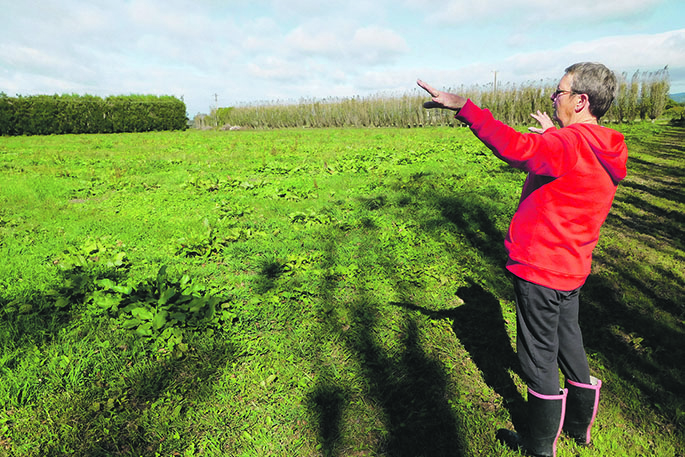Kitchen cupboards turned to Weetbix, valuation hiccups and premature retirement are just some of the challenges Bay of Plenty kiwifruit orchardists Carol and John Harold have faced – and overcome with remarkable positivity and “a few smokes and a bit of beer” – in the year since the Edgecumbe flood. The Harolds have lived on their Otakiri Rd orchard, 3km from Edgecumbe, since 1992. On April 6 last year, a drain on their property overflowed and despite their best efforts to pump the water into a nearby canal, the Edgecumbe stopbank breach meant the water just made its way back around – rendering the entire property and house a two-foot deep “lake” that sat for seven days. “Never ever in our wildest dreams did we imagine we’d have to worry about the house,” says John. “We’re pretty low here and it usually fills up around the clothesline, but you never worry about the house. Never.” Back to normal Despite the monumental mess that followed, the Harolds, one year on, are looking to the future with remarkable positivity, and have no plans to leave. “We’re pretty much back to normal,” says John. “The builders and contractors are all done on the house, with the exception of the swimming pool, and we’re just pottering around putting the finishing touches together. Once the inside is finished the exterior work will begin, such as replacing paving stones, and a little shed work.” The couple spent the nine months following the flood living in a shed and caravan on their property, undertaking all stripping and deconstruction work themselves before contractors and builders took over. Living on-site had its benefits, such as added security from looters, but also presented some challenges. “The stink from the water was incredible,” says Carol. “Inside the house, there was condensation dripping from the ceiling. And the worms – yuck!” The Harolds are grateful their insurance company, AMI, was excellent to deal with. “They were absolutely marvellous,” says John. “We went into the office after Easter weekend and made a claim, and the assessor rang us either that afternoon or the next day and came out. We had one person looking after us all the way through.” The only frustration the Harolds encountered was getting a valuation that met the quality of the chattels that were destroyed, resulting in some to-ing and fro-ing until an agreement was met. “All of those things just slowed the process down.” They also discovered they couldn’t find new wooden furniture, such as hutch dressers, that were made to the quality of those ruined in the flood. Carol and her daughter ended up purchasing several replacement pieces from second-hand stores. Beyond salvage Inside some of the furniture destroyed in the flood was, to the couple’s distress, a large collection of photographs that couldn’t be salvaged despite their best efforts. “They included photos of the building and maiden voyage of the Island Princess, which was owned by my former husband and I,” says Carol. “Thankfully I’d created a scrapbook of newspaper clippings, which survived the flood water, but there were additional photos that weren’t able to be saved.” The Harold’s 1.8ha kiwifruit orchard, which grew a mixture of green and gold fruit, was beyond salvage and was removed, with no plans to replant. “We originally had Hort 16A gold kiwifruit, but that was ravaged by Psa-V and we replaced it with G3,” says John. “Unfortunately, the Psa was still existing in the ground, and with all the extra stress of the flood, it got stuck into the G3. Psa loves wet conditions; if there’s any virus around, it’ll get you. The rest was pulled out too, as it was dying; the flood killed it.” Six months after the flood the Rangitaiki River Scheme Review, commissioned by the Bay of Plenty Regional Council, was released containing 29 recommendations to the council – but to John and Carol’s frustration, there was no blame assigned. “What a waste of time and money,” says John. “No one came up with any blame, but it’s so clear the blame is on the council – they didn’t fix that wall. “Half a million dollars for nothing. Everyone just laughed; that’s the basic feeling around here.” Despite frustrations surrounding the inquiry, the Harolds have continued to look for the positives wherever possible. They are settling back into normal life, with the weight of orchard work off their shoulders. “It’s quite good now because we don’t have to go out every day and prune and muck around with the kiwifruit,” says John. “Okay, we haven’t got the income from it anymore, but we’re alright.”
Saturday, April 20, 2024
Posted: 9:34am Friday 06 Apr, 2018 | By Anne Boswell
Retiring from kiwifruit after the flood

Carol Harold stands in the empty paddock that once contained the couple’s kiwifruit orchard, ravaged by a recurrence of Psa-V after the Edgecumbe floods.


0 Comments
Leave a Comment